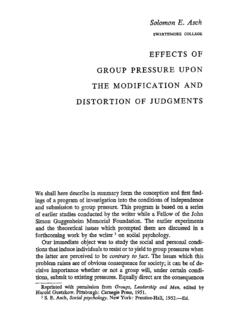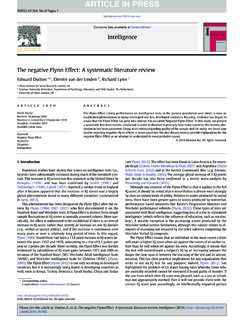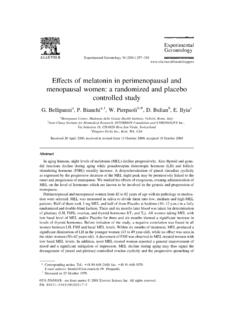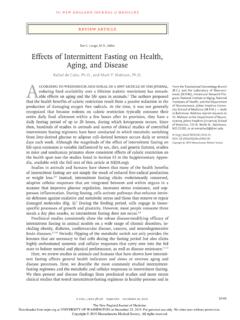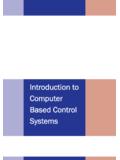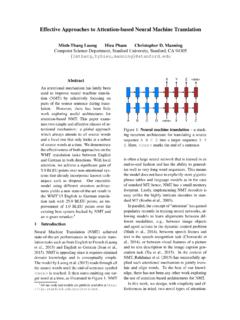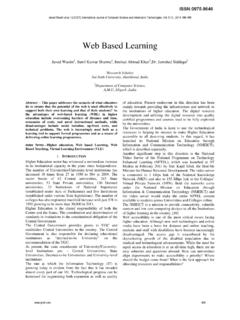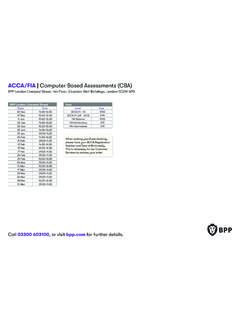Transcription of Computer Based Horse Race Handicapping and Wagering ...
1 Computer Based Horse Race Handicapping and Wagering Systems: A Report William Benter HK Betting Syndicate, Hong Kong ABSTRACT. This paper examines the elements necessary for a practical and successful computerized Horse race Handicapping and Wagering system. Data requirements, Handicapping model development, Wagering strategy, and feasibility are addressed. A logit- Based technique and a corresponding heuristic measure of improvement are Efficiency of Racetrack Betting Markets Downloaded from described for combining a fundamental Handicapping model with the public's implied probability estimates.
2 The author reports sigmficant positive results in five by UNIVERSITY OF QUEENSLAND on 05/05/16. For personal use only. years of actual implementation of such a system. This result can be interpreted as evidence of inefficiency in pari-mutuel racetrack Wagering . This paper aims to emphasize those aspects of Computer Handicapping which the author has found most important in practical application of such a system. INTRODUCTION. The question of whether a fully mechanical system can ever "beat the races" has been widely discusscd in both the academic and popular literature.
3 Cettun authors have convincingly demonstrated that profitable Wagering systems do exist for the races. The most well documented of these have generally been of the technical variety, that is, they are concerned mainly with the public odds, and do not attempt to predict Horse performance from fundamental factors. Technical systems for place and show betting, (Ziemba and Hausch, 1987) and exotic pool betting, (Ziemba and Hausch, 1986) as well as the 'odds movement' system developed by Asch and Quandt (1986), fall into t h i s category. A benefit of these systems is that they require relatively little preparatory effort, and can be effectively employed by the occasional racegoer.
4 Their downside is that betting opportunities tend to occur infrequently and the maximum expected profit achievable is usually relatively modest. It is debatable whether any racetracks exist where these systems could be profitable enough to sustain a full-time professional effort. To be truly viable, a system must provide a large number of high advantage betting opportunities in order that a sufhient amount of expected profit can be generated. An approach which does promise to provide a large number of betting opportunities is to fundamentally handicap each race, that is, to empirically assess each Horse 's chance of winning, and utilize that assessment to find profitable Wagering opportunities.
5 A natural way to attempt to do this is to develop a Computer model to estimate each Horse 's probability of winning and calculate the appropriate amount to wager. A complete survey of this subject is beyond the scope of this paper. The general requirements for a Computer Based fundamental Handicapping model have been well presented by Bolton and Chapman (1986) and Brecher (1980). These two references are "required reading" for anyone interested in developing such a system. Much of what is said here has already been explained in those two works, as is much of the theoretical background which has been omitted here.
6 What the author would hope to add, is a discussion of a few points which have not been addressed in the literature, some practical recommendations, and a report that a fundamental approach can in fact work in practice. FEATURES OF THE Computer Handicapping APPROACH. Several features of the Computer approach give it advantages over traditional Handicapping . First, because of its empirical nature, one need not possess specific Handicapping expertise to undertake this cnterprise, as everything one needs to know can be learned from the data. Second is the testability of a Computer system.
7 By carefully partitioning data, one can develop a model and test it on unseen races. With this procedure one avoids the danger of overfitting past data. Using this 'holdout' technique, one can obtain a reasonable estimate of the system's real-time performance before Wagering any actual 183. 184 W. BENTER. money. A third positive attribute of a computerized Handicapping system is its consistency. Handicapping races manually is an extremely taxing undertaking. A Computer will effortlessly handicap races with the same level of care day after day, regardless of the mental state of the operator.
8 This is a non-trivial advantage considering that a professional level betting operation may want to bet several races a day for extended periods. The downside of the Computer approach is the level of preparatory effort necessary to develop a winning system. Large amounts of past data must be collected, verified and computerized. In the past, this has meant considerable manual entry of printed data. This situation may be changing as optical scanners can speed data entry, and as more online horseracing database services become available. Additionally, several man-years of programming and data analysis will probably be necessary to develop a sufkiently profitable system.
9 Given these considerations, it is clear that the Computer approach is not suitable for the casual racegoer. Efficiency of Racetrack Betting Markets Downloaded from Handicapping MODEL DEVELOPMENT. by UNIVERSITY OF QUEENSLAND on 05/05/16. For personal use only. The most Wicult and time-consuming step in creating a Computer Based betting system is the development of the fundamental Handicapping model. That is, the model whose final output is an estimate of each Horse 's probability of winning. The type of model used by the author is the multinomial logit model proposed by Bolton and Chapman (1986).
10 This model is well suited to Horse racing and has the convenient property that its output is a set of probability estimates which sum to 1. within each race. The overall goal is to estimate each Horse 's current performance potential. "Current performance potential" being a single overall summruy index of a Horse 's expected performance in a particular race. To construct a model to estimate current performance potential one must investigate the available data to find those variables orfactors which have predictive significance. The profitability of the resulting betting system will be largely determined by the predictive power of the factors chosen The odds set by the public betting yield a sophisticated estimate of the horses' win probabilities.
